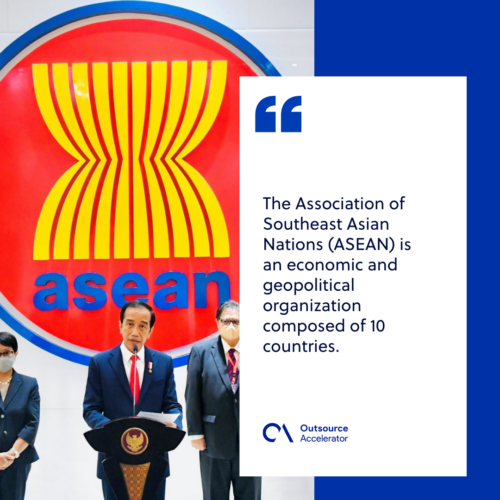Association of Southeast Asian Nations (ASEAN)
Definition
What is the Association of Southeast Asian Nations?
The Association of Southeast Asian Nations (ASEAN) is an economic and geopolitical organization composed of 10 countries from the region:
- Brunei Darussalam
- Cambodia
- Indonesia
- Lao People’s Democratic Republic (Laos)
- Malaysia
- Myanmar
- The Philippines
- Singapore
- Thailand
- Vietnam
The ASEAN was established on August 8, 1967, in Bangkok, Thailand, through the ASEAN Declaration. The declaration was signed by the then foreign ministers of the association’s founding member states, who subsequently became known as the ASEAN’s founding fathers:
- Adam Malik (Indonesia)
- Tun Abdul Razak (Malaysia)
- Narciso R. Ramos (the Philippines)
- S. Rajaratnam (Singapore)
- Thanat Khoman (Thailand)
Initially, the organization only had the abovementioned five member states. The other five ASEAN member countries only joined years later.
- Brunei joined on January 8, 1984;
- Vietnam on July 28, 1995;
- Laos and Myanmar on July 23, 1997;
- and Cambodia on April 30, 1999.

What is the purpose of the ASEAN?
The ASEAN was founded with two primary objectives in mind. The first is to fast-track the region’s growth and social, economic, and cultural development. The second is to promote and maintain peace and stability through adherence to the rule of law and the principles of the United Nations Charter.
Aside from its key objectives, the ASEAN Declaration also tasked the organization with the following duties:
- foster and develop Southeast Asian studies;
- lobby for more active cooperation and bilateral assistance between member states on matters of mutual interests in social, cultural, economic, scientific, technical, and administrative fields;
- provide mutual aid with other member states through training and research facilities in the areas of education and professional, administrative, and technical spheres;
- improve cooperation with other member states to promote further industrial, agricultural, and trade growth;
- maintain close and advantageous relationships with regional and international organizations that share similar objectives with the ASEAN.
The organizational structure of the ASEAN
The ASEAN’s Secretariat was introduced on February 24, 1976, by the organization’s then foreign ministers. The Secretariat was mandated to “provide for greater efficiency in the coordination of ASEAN organs and for more effective implementation of ASEAN projects and activities.”
Establishing the Secretariat also more clearly delineated the ASEAN’s organizational structure. Initially, the Secretariat was composed of the following:
- Secretary-General
- three Bureau Directors
- Foreign Trade and Economics Relations Officer
- Administrative Officer
- Public Information Officer
- Assistant to the Secretary-General
However, the ASEAN has made several amendments to the Secretariat since its establishment.
- 1983. An amendment was made that allowed for the possible expansion of the Secretariat personnel by inserting a clause under Article 4 “and such other officers, as the Standing Committee may deem necessary.”
- 1985. The Secretary-General’s office tenure was increased from two years to three years.
- 1989. New posts were added: one Deputy Secretary-General and nine Assistant Directors.
- 1992. The Secretariat’s Secretary-General was redesignated as Secretary-General of the ASEAN, and its tenure was increased to five years.
- 1997. A second Deputy Secretary-General post was added.
At present, the ASEAN also has three community councils, each of which is tasked with its own objectives. The three councils are:
- the ASEAN Political-Security Community (APSC) Council;
- the ASEAN Socio-Cultural Community (ASCC) Council; and
- the ASEAN Economic Community (AEC) Council.
Is the ASEAN a success?
The ASEAN can be considered successful in achieving its goals for the region. Before the organization’s establishment, the idea of regional cooperation among Southeast Asian countries was a highly improbable notion.
Southeast Asia was and still is a melting pot of various cultures and languages, not to mention political diversity with its mix of republics, monarchies, a sultanate, and communist states. Unlike other regional organizations, such as the European Union, the ASEAN member states hardly have any commonality.
Despite the differences among its members, the organization has been hugely successful in improving the region’s economy.
In fact, ASEAN’s economic growth has outperformed the rest of the world. The organization’s combined GDP is presently at $2.5T, making it the fifth-largest economy globally. It is forecasted to move up to fourth place by 2030.







 Independent
Independent




